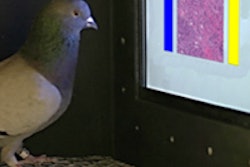
It doesn't take IBM's Watson artificial intelligence software to discern that the computing giant has big plans for its planned acquisition of PACS and imaging software firm Merge Healthcare. Indeed, IBM views medical imaging as a key element of its vision to transform healthcare with cognitive computing and analytics.
IBM envisions a future where its Watson technology will, for example, be utilized to help physicians utilize image data and other patient information to compare their patients with others who have similar pathologies to arrive at the best treatment decision.
"[Medical] images have a big role in providing a full comprehensive view of the patient, and it will have an even bigger role into the insights that one can derive from the multimodal dataset about patients and patient populations," said Shahram Ebadollahi, PhD, chief scientific officer for IBM's fledgling Watson Health unit.
Watson in the cloud
Launched in April, Watson Health -- the company's first dedicated industry-specific business unit -- has introduced Watson Health Cloud, which applies the Watson cognitive computing technology to a cloud-based platform for physicians, researchers, insurers, and companies to gain individualized insights on patients and health.
"Watson Health Cloud is designed to bring data at scale together and enable derivation of insights from the multimodal data," Ebadollahi told AuntMinnie.com. "The [Merge acquisition] gets us one step closer to where we want to go, which is to create the platform, but most importantly, create insights at scale, do it in a secure fashion, and provide it as a service in support of solutions that need to be built in order to transform our healthcare business in this country and in other places."
Merge will join other recent acquisitions Explorys -- a developer of cloud-based healthcare analytics software -- and Phytel -- a provider of cloud-based services for population health management -- in the Watson Health family, which also encompasses IBM's own analytics and cognitive computing technology. IBM has also inked partnerships with companies such as Apple, Johnson & Johnson, and Medtronic in support of Watson Health Cloud.
Cognitive computing, analytics
The acquisition of Merge offers opportunity for IBM on two fronts, Ebadollahi said. First, IBM's cognitive computing, analytics, and machine-learning techniques could be incorporated as incremental additions to Merge's many offerings in areas such as radiology and cardiology, for example.
"We have been doing a lot of work in our research labs for the last five to 10 years on advanced algorithms and deep-learning methodologies on medical images of different modalities with different organs," he said.
It's too early to tell when these technologies will be added to Merge software for use by customers, but some elements are expected to be available in 2016, he said.
Next, Merge brings a substantial installed base that offers the potential of big-data analytics. IBM believes that one of the biggest differentiators for Watson Health and Watson Health Cloud is to provide both knowledge- and data-driven analytics of multiple data sources on a large scale, Ebadollahi said.
"[With] knowledge-driven [analytics] you are pointing the machine ... to sources of knowledge, repositories of knowledge; these may be books, guidelines, publications, or institutional know-how that have been captured and documented," he said. "The machine's role in that scenario in cognitive computing is to understand the context of a patient-provider interaction or whatever the use may be, and go back to those knowledge repositories and extract that piece of evidence and insight that may relate to that particular decision that's being made or informs that decision."
Data-driven analytics, however, takes into account collective datasets of different modalities and applies machine-learning technology to observational data to determine "what has happened, what has worked, what didn't work, what related to what type of outcome and cost structure, and so on and so forth," he said.
"At the end of the day, you need to bring together both types of insight -- from knowledge and from data -- to inform those solutions for various kinds of healthcare and life sciences," Ebadollahi said.
IBM imaging research
IBM has been actively engaged for years in several imaging research projects in its research labs, including a melanoma-oriented initiative that involves detecting anomalies and assessing change on visible light images. Imaging represents an interesting space to apply cognitive technologies, as it frequently involves qualitative observations such as commenting on shapes and textures or certain lesions, Ebadollahi said.
"Through that melanoma work, what we have done is characterize texture, shape, and color of images -- basically translating the image into a very long set of features that could be extracted from the image -- and then using deep machine-learning tools over a population of patients who have that kind of disease to learn the definition automatically of what is normal and what is abnormal," he said. "And then being able to distinguish between these kinds of things without really knowing; nobody can sit there and define for the computer what normal is. The machine has to learn it from those repositories of example images."
The other major imaging informatics project, called Medical Sieve, seeks to develop a virtual "sieve" that filters essential clinical and diagnostic imaging information and provides radiologists with summaries of anomalies and recommendations.
Medical Sieve first gathers patient data from a IT systems such as electronic medical records, pharmacy information systems, laboratory information systems, and admission, discharge, and transfer systems, as well as radiology and cardiology PACS. It then makes use of text and image processing, as well as pattern-recognition and machine-learning techniques, to provide summaries that indicate anomalies.
It also summarizes the imaging studies that capture the most salient anomalies, IBM said. Patient similarity analysis could then be performed.
"If you observe these kinds of patterns in these type of patients in these types of datasets and if you have access to anonymized population data of the same type, then you can extract out and learn the signature pattern that actually makes that person similar in the manifestation of the disease to these other pockets of people," Ebadollahi said. "[They can] then pull up those people, see what was done to them, see what outcomes were achieved, and, therefore, inform this particular decision for the patient."
Achievements in the Medical Sieve program so far include an automatic spatiotemporal coronary stenosis detection and localization technique for x-ray angiography studies, methods for breast lesion discrimination, and automated production of segment models for cardiac MRI diagnosis, according to the vendor.
With regard to anonymized population data that could be utilized by Merge customers, it's too early to tell how this will be implemented, he said.
"To feed these kinds of algorithms, machine learning, and cognitive computing, [the] datasets for different purposes and algorithms will be different based on what you're trying to do," Ebadollahi said. "In this particular case, it will be deidentified types of data that could be used for this, but we haven't started, so I can't comment on exactly what is going to be used and how it's going to be used. But it will be deidentified."
IBM's purchase of Merge is expected to be completed later this year.




















